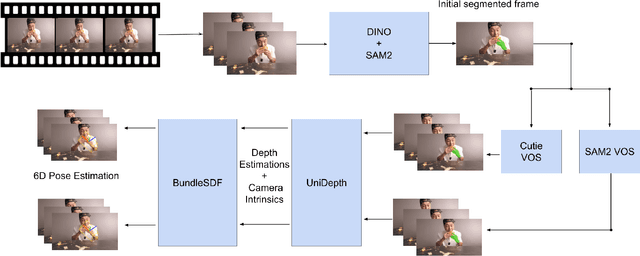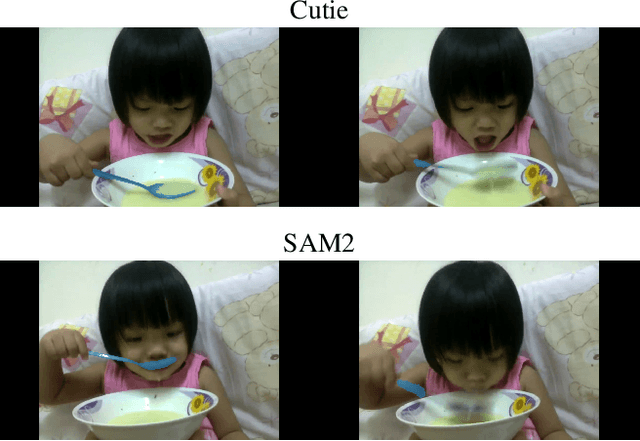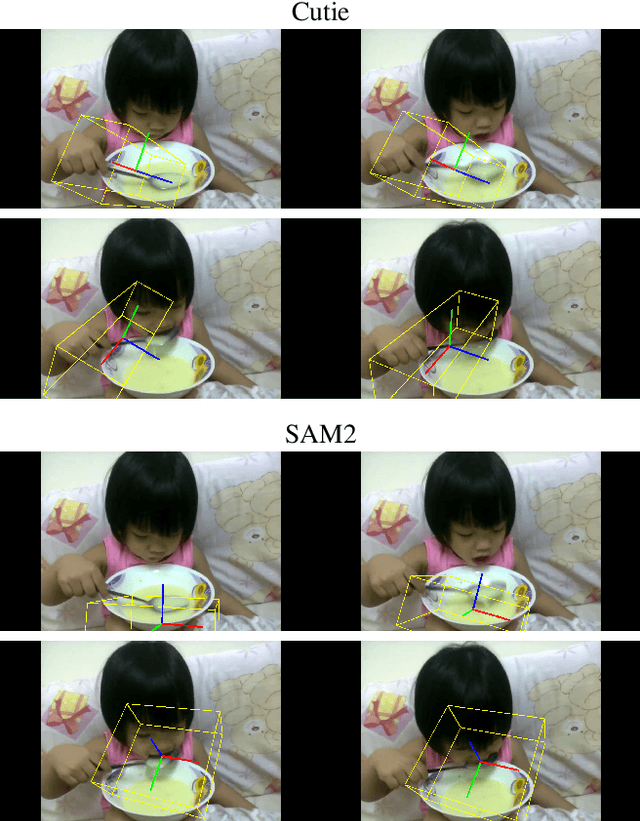Yuhao Chen
TeaRAG: A Token-Efficient Agentic Retrieval-Augmented Generation Framework
Nov 07, 2025Abstract:Retrieval-Augmented Generation (RAG) utilizes external knowledge to augment Large Language Models' (LLMs) reliability. For flexibility, agentic RAG employs autonomous, multi-round retrieval and reasoning to resolve queries. Although recent agentic RAG has improved via reinforcement learning, they often incur substantial token overhead from search and reasoning processes. This trade-off prioritizes accuracy over efficiency. To address this issue, this work proposes TeaRAG, a token-efficient agentic RAG framework capable of compressing both retrieval content and reasoning steps. 1) First, the retrieved content is compressed by augmenting chunk-based semantic retrieval with a graph retrieval using concise triplets. A knowledge association graph is then built from semantic similarity and co-occurrence. Finally, Personalized PageRank is leveraged to highlight key knowledge within this graph, reducing the number of tokens per retrieval. 2) Besides, to reduce reasoning steps, Iterative Process-aware Direct Preference Optimization (IP-DPO) is proposed. Specifically, our reward function evaluates the knowledge sufficiency by a knowledge matching mechanism, while penalizing excessive reasoning steps. This design can produce high-quality preference-pair datasets, supporting iterative DPO to improve reasoning conciseness. Across six datasets, TeaRAG improves the average Exact Match by 4% and 2% while reducing output tokens by 61% and 59% on Llama3-8B-Instruct and Qwen2.5-14B-Instruct, respectively. Code is available at https://github.com/Applied-Machine-Learning-Lab/TeaRAG.
Specific multi-emitter identification via multi-label learning
Sep 26, 2025Abstract:Specific emitter identification leverages hardware-induced impairments to uniquely determine a specific transmitter. However, existing approaches fail to address scenarios where signals from multiple emitters overlap. In this paper, we propose a specific multi-emitter identification (SMEI) method via multi-label learning to determine multiple transmitters. Specifically, the multi-emitter fingerprint extractor is designed to mitigate the mutual interference among overlapping signals. Then, the multi-emitter decision maker is proposed to assign the all emitter identification using the previous extracted fingerprint. Experimental results demonstrate that, compared with baseline approach, the proposed SMEI scheme achieves comparable identification accuracy under various overlapping conditions, while operating at significantly lower complexity. The significance of this paper is to identify multiple emitters from overlapped signal with a low complexity.
GS: Generative Segmentation via Label Diffusion
Aug 27, 2025Abstract:Language-driven image segmentation is a fundamental task in vision-language understanding, requiring models to segment regions of an image corresponding to natural language expressions. Traditional methods approach this as a discriminative problem, assigning each pixel to foreground or background based on semantic alignment. Recently, diffusion models have been introduced to this domain, but existing approaches remain image-centric: they either (i) use image diffusion models as visual feature extractors, (ii) synthesize segmentation data via image generation to train discriminative models, or (iii) perform diffusion inversion to extract attention cues from pre-trained image diffusion models-thereby treating segmentation as an auxiliary process. In this paper, we propose GS (Generative Segmentation), a novel framework that formulates segmentation itself as a generative task via label diffusion. Instead of generating images conditioned on label maps and text, GS reverses the generative process: it directly generates segmentation masks from noise, conditioned on both the input image and the accompanying language description. This paradigm makes label generation the primary modeling target, enabling end-to-end training with explicit control over spatial and semantic fidelity. To demonstrate the effectiveness of our approach, we evaluate GS on Panoptic Narrative Grounding (PNG), a representative and challenging benchmark for multimodal segmentation that requires panoptic-level reasoning guided by narrative captions. Experimental results show that GS significantly outperforms existing discriminative and diffusion-based methods, setting a new state-of-the-art for language-driven segmentation.
Xiangqi-R1: Enhancing Spatial Strategic Reasoning in LLMs for Chinese Chess via Reinforcement Learning
Jul 16, 2025Abstract:Game playing has long served as a fundamental benchmark for evaluating Artificial General Intelligence (AGI). While Large Language Models (LLMs) have demonstrated impressive capabilities in general reasoning, their effectiveness in spatial strategic reasoning, which is critical for complex and fully observable board games, remains insufficiently explored. In this work, we adopt Chinese Chess (Xiangqi) as a challenging and rich testbed due to its intricate rules and spatial complexity. To advance LLMs' strategic competence in such environments, we propose a training framework tailored to Xiangqi, built upon a large-scale dataset of five million board-move pairs enhanced with expert annotations and engine evaluations. Building on this foundation, we introduce Xiangqi-R1, a 7B-parameter model trained in multi-stage manner: (1) fine-tuning for legal move prediction to capture basic spatial rules, (2) incorporating strategic annotations to improve decision-making, and (3) applying reinforcement learning via Group Relative Policy Optimization (GRPO) with multi-dimensional reward signals to enhance reasoning stability. Our Experimental results indicate that, despite their size and power, general-purpose LLMs struggle to achieve satisfactory performance in these tasks. Compared to general-purpose LLMs, Xiangqi-R1 greatly advances with an 18% rise in move legality and a 22% boost in analysis accuracy. Our results point to a promising path for creating general strategic intelligence in spatially complex areas.
Ice Hockey Puck Localization Using Contextual Cues
Jun 04, 2025Abstract:Puck detection in ice hockey broadcast videos poses significant challenges due to the puck's small size, frequent occlusions, motion blur, broadcast artifacts, and scale inconsistencies due to varying camera zoom and broadcast camera viewpoints. Prior works focus on appearance-based or motion-based cues of the puck without explicitly modelling the cues derived from player behaviour. Players consistently turn their bodies and direct their gaze toward the puck. Motivated by this strong contextual cue, we propose Puck Localization Using Contextual Cues (PLUCC), a novel approach for scale-aware and context-driven single-frame puck detections. PLUCC consists of three components: (a) a contextual encoder, which utilizes player orientations and positioning as helpful priors; (b) a feature pyramid encoder, which extracts multiscale features from the dual encoders; and (c) a gating decoder that combines latent features with a channel gating mechanism. For evaluation, in addition to standard average precision, we propose Rink Space Localization Error (RSLE), a scale-invariant homography-based metric for removing perspective bias from rink space evaluation. The experimental results of PLUCC on the PuckDataset dataset demonstrated state-of-the-art detection performance, surpassing previous baseline methods by an average precision improvement of 12.2% and RSLE average precision of 25%. Our research demonstrates the critical role of contextual understanding in improving puck detection performance, with broad implications for automated sports analysis.
FoodTrack: Estimating Handheld Food Portions with Egocentric Video
May 07, 2025Abstract:Accurately tracking food consumption is crucial for nutrition and health monitoring. Traditional approaches typically require specific camera angles, non-occluded images, or rely on gesture recognition to estimate intake, making assumptions about bite size rather than directly measuring food volume. We propose the FoodTrack framework for tracking and measuring the volume of hand-held food items using egocentric video which is robust to hand occlusions and flexible with varying camera and object poses. FoodTrack estimates food volume directly, without relying on intake gestures or fixed assumptions about bite size, offering a more accurate and adaptable solution for tracking food consumption. We achieve absolute percentage loss of approximately 7.01% on a handheld food object, improving upon a previous approach that achieved a 16.40% mean absolute percentage error in its best case, under less flexible conditions.
6D Pose Estimation on Spoons and Hands
May 05, 2025



Abstract:Accurate dietary monitoring is essential for promoting healthier eating habits. A key area of research is how people interact and consume food using utensils and hands. By tracking their position and orientation, it is possible to estimate the volume of food being consumed, or monitor eating behaviours, highly useful insights into nutritional intake that can be more reliable than popular methods such as self-reporting. Hence, this paper implements a system that analyzes stationary video feed of people eating, using 6D pose estimation to track hand and spoon movements to capture spatial position and orientation. In doing so, we examine the performance of two state-of-the-art (SOTA) video object segmentation (VOS) models, both quantitatively and qualitatively, and identify main sources of error within the system.
SAMJAM: Zero-Shot Video Scene Graph Generation for Egocentric Kitchen Videos
Apr 10, 2025Abstract:Video Scene Graph Generation (VidSGG) is an important topic in understanding dynamic kitchen environments. Current models for VidSGG require extensive training to produce scene graphs. Recently, Vision Language Models (VLM) and Vision Foundation Models (VFM) have demonstrated impressive zero-shot capabilities in a variety of tasks. However, VLMs like Gemini struggle with the dynamics for VidSGG, failing to maintain stable object identities across frames. To overcome this limitation, we propose SAMJAM, a zero-shot pipeline that combines SAM2's temporal tracking with Gemini's semantic understanding. SAM2 also improves upon Gemini's object grounding by producing more accurate bounding boxes. In our method, we first prompt Gemini to generate a frame-level scene graph. Then, we employ a matching algorithm to map each object in the scene graph with a SAM2-generated or SAM2-propagated mask, producing a temporally-consistent scene graph in dynamic environments. Finally, we repeat this process again in each of the following frames. We empirically demonstrate that SAMJAM outperforms Gemini by 8.33% in mean recall on the EPIC-KITCHENS and EPIC-KITCHENS-100 datasets.
Towards Secure Semantic Communications in the Presence of Intelligent Eavesdroppers
Mar 29, 2025Abstract:Semantic communication has emerged as a promising paradigm for enhancing communication efficiency in sixth-generation (6G) networks. However, the broadcast nature of wireless channels makes SemCom systems vulnerable to eavesdropping, which poses a serious threat to data privacy. Therefore, we investigate secure SemCom systems that preserve data privacy in the presence of eavesdroppers. Specifically, we first explore a scenario where eavesdroppers are intelligent and can exploit semantic information to reconstruct the transmitted data based on advanced artificial intelligence (AI) techniques. To counter this, we introduce novel eavesdropping attack strategies that utilize model inversion attacks and generative AI (GenAI) models. These strategies effectively reconstruct transmitted private data processed by the semantic encoder, operating in both glass-box and closed-box settings. Existing defense mechanisms against eavesdropping often cause significant distortions in the data reconstructed by eavesdroppers, potentially arousing their suspicion. To address this, we propose a semantic covert communication approach that leverages an invertible neural network (INN)-based signal steganography module. This module covertly embeds the channel input signal of a private sample into that of a non-sensitive host sample, thereby misleading eavesdroppers. Without access to this module, eavesdroppers can only extract host-related information and remain unaware of the hidden private content. We conduct extensive simulations under various channel conditions in image transmission tasks. Numerical results show that while conventional eavesdropping strategies achieve a success rate of over 80\% in reconstructing private information, the proposed semantic covert communication effectively reduces the eavesdropping success rate to 0.
Deep Learning for Time Series Forecasting: A Survey
Mar 13, 2025Abstract:Time series forecasting (TSF) has long been a crucial task in both industry and daily life. Most classical statistical models may have certain limitations when applied to practical scenarios in fields such as energy, healthcare, traffic, meteorology, and economics, especially when high accuracy is required. With the continuous development of deep learning, numerous new models have emerged in the field of time series forecasting in recent years. However, existing surveys have not provided a unified summary of the wide range of model architectures in this field, nor have they given detailed summaries of works in feature extraction and datasets. To address this gap, in this review, we comprehensively study the previous works and summarize the general paradigms of Deep Time Series Forecasting (DTSF) in terms of model architectures. Besides, we take an innovative approach by focusing on the composition of time series and systematically explain important feature extraction methods. Additionally, we provide an overall compilation of datasets from various domains in existing works. Finally, we systematically emphasize the significant challenges faced and future research directions in this field.
 Add to Chrome
Add to Chrome Add to Firefox
Add to Firefox Add to Edge
Add to Edge